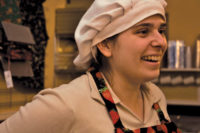No matter how gloomy the weather, the economy or even the politics, Carnival season in Cologne brings out the smiles in everyone. People parading in costume, the local breweries doling out kölsch (beer brewed in Cologne only) continuously and the world’s largest confectionery fair all help with the mood.
Visitors and participants attending the 42nd International Sweets & Biscuits Fair shared those smiles, albeit faced with non-carnival like realities: consolidation, rising commodity prices and retailer pressures.
Nonetheless, this year’s ISM once again generated a heightened sense of optimism for those attending, if only to allow exhibitors and buyers to commiserate about what it takes to sell sweets and snacks in suspect economic times. Despite the global economy’s fragility, there remains guarded anticipation that all will be… well, sweet.
And although show numbers remain consistent — 35,000 attendees from around 130 countries; 1,412 suppliers from 65 countries — it was clear that the absence of many multinationals has shrunk ISM’s expanse.
Its importance, however, hasn’t waned, particularly for midsized confectioners and those in developing nations.
Moreover, the show continues to serve as the largest stage for jumpstarting trends and/or reinvigorating existing concepts, companies and cooperation. This year was no exception. Initial observations by the organizers of the fair, Koelnmesse and the International Sweets and Biscuits Fair Working Group, underscored a key movement dubbed “Purity.” There’s no doubt that many chocolate manufacturers are not only accenting origin, but also how the cocoa beans are cultivated and harvested.
Hence, sustainability and certification, be it Fair Trade, UTZ, Rainforest Alliance or personal assurance, come into play. Although the trend is more pronounced in Europe, particularly for chocolate, it’s clear that this socially conscious connection is going global and will continue to play a large role with consumers.
The Hershey Co.’s recent announcement that its Bliss brand of candies will be made with Rainforest Alliance-certified chocolate by the end of the year reaffirms purity’s reach.
It’s interesting to note that two major German sugar confectionery companies, Katjes Fassin GmbH and the Mederer Group, also are touting purity and their sourcing of ingredients.
Katjes’ Managing Director Tobias Bachmüller, the head of one of Germany’s top chewy, licorice and fizzy powder candy companies, emphasized the switch from gelatin to an “all-vegetarian” ingredient statement for many of the company’s top-selling products as a major directive for the company.
As a means of underscoring the move, green-eared “bunnies” greeted show visitors to the company’s booth. As Bachmüller explains, although not everyone is a vegetarian, many women indicate they only eat meat once or twice weekly. Given that women are the target group for many of Katjes’ sweet products, the idea of a “green-eared rabbit seal” to symbolize the lack of any meat-based ingredients (gelatin) reflects a fun way to accent the product’s veggie roots.
Then, there’s Herbert Mederer, the ever creative managing director of the Mederer Group. Keeping in stride with the purity movement, the company’s launched a line of Trolli gummies that shout Fair Trade sourcing of ingredients with its packaging. And while certification underscores purity, vitamins emphasize better-for-you — another ongoing trend at the fair. No surprise that the company also has introduced a line of Trolli Vitamin fruit gums.
But Mederer wouldn’t be Mederer without offering chocolate-covered gummi rings, a treat no adult or child could resist, no matter how socially conscious they are.
Visitors walking the show also took in other trends having an impact on product launches. One notable example involves a broader willingness to experiment with aromas, spices, and atypical flavors.
Thus, a white chocolate bar featuring aloe vera or containing algae and cranberries — both from Bucker’s Backhaus — certainly take confectionery experimentation to another level.
Then there’s an ongoing effort by confectioners to deliver to consumers a healthier product, one that doesn’t contain allergens or even sugar.
Manufacturers touting that their products were made with stevia, a recently approved ingredient in the European Union, were much more noticeable through the show floor.
In addition, packaging continues to play a more important role for manufacturers that don’t have a strong brand awareness. Glam and cutting-edge designs dovetail with traditional high-end presentations. German-based Peters provides an excellent example of how Advent calendars can be revitalized with novel interpretations, using books, games and more sophisticated approaches to attract a “hipper” audience.
Several of the trends mentioned were evident at ISM’s new product showcase, which received 112 entries from 78 companies anxious to tout their innovative items.
The top three winners, as determined by ballots from 80 journalists attending the fair, provide a shapshot of what’s capturing the attention of product developers.
Cavalier N. V. took top honors with its line of chocolate products made with stevia. Last year the Belgian company and Barry Callebaut jointly developed a semisweet chocolate sweetened with stevia. Since then this innovation has been further refined, and now there is a complete assortment of products that includes pralines, chocolate bars and flat chocolate bars.
Second place went to ültje GmbH’s Crispers, which are peanuts that feature a crust in either curry sausage and hamburger flavors. Naturally, their launch will coincide with the European Football Championship games coming this summer, just in time for a bit of soccer snacking.
And third place went to PEZ International GmbH’s PEZ soft fruit gums. Playing off its well-loved and established dispenser ofPEZ candies, the company developed all-natural, gluten and lactose-free soft gummies, complete with a — surprise, surprise — special dispenser that allows children (and/or adults) to shoot the wonderful sweets directly in their mouths.
Personalization certainly seemed to be high on the mind of many manufacturers. For example, Guylian Belgian Chocolates debuted its LetterBoxGifts line, which combines the joy of receiving a greeting card with the bliss of eating chocolate.
TheLetterBox Gifts concept provides consumers with a high quality greeting card that features room for a personal message, a mailer box that’s easily addressable and a choice of six Guylian’s Temptations (Belgian Chocolate seahorses) or six Belgian milk chocolate hearts filled with hazelnut praline.
The company has also launched two new chocolate lines under the Perlines name: pralines featuring Guylian hazelnut praline and a creamy milk truffle filling enrobed in white, milk and dark chocolate.
Innovation and inspiration continue to be themes everyone’s striving for, with manufacturers finding different avenues to attain both. At Rübezahl Schokoladen, the company continues to maintain its association — and vice versa — with three-star Michelin chef Harald Wohlfart.
Wohlfart focuses on using fresh ingredients, often giving familiar German favorites a fresh confectionery twist. The emphasis on sourcing has taken several quantum leaps at the company. Besides committing to using UTZ-certified chocolate for nearly all of Rubezahl’s chocolate products by 2013, the company is touting its Black Forest sourcing of ingredients such as cherries, raspberries, and yellow plum liqueurs for certain Gubor products.
Thanks to ongoing development, the company is ready to roll out its Choco Gummis product on a broad scale, the fine-tuning of proprietary technology now completed.
Loacker’s latest product also boasts of using proprietary technology. The Fogliette (Little Leaves) wafer product, which was nearly four years in development, uses new proprietary equipment to create an airy wafer that’s covered in either milk or dark chocolate. The company also will expand its rollout of its Rose of the Dolomites pralines in the United States as well as launch chocolate-enrobed Quadratinis.
Trying to connect with consumers continues to be critically important for all confectionery companies. Consider ABICAB, (the Brazilian Association of Cacao, Chocolates, Candies and By-Products Industry) which launched a new logo to emphasize its innovation, emotion and affection.
The rainbow-colored heart, reinforced by the tagline, “Made from the Heart,” highlights the idea that “Brazilians do everything with emotion and affection,” says Solange Isidoro, vice president of ABICAB, and export manager for Embare.
Brazilian companies that export will now be using the logo on their packaging as part of the campaign to let consumers know that Brazil’s confectionery industry, ranked third in the world, produces all of its sweets with love.
That’s probably why ISM continues to bring smiles to both buyers and sellers.


















